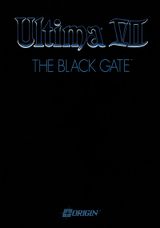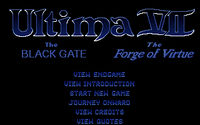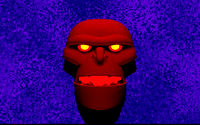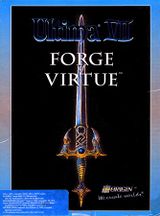Ultima VII: The Black Gate
This article is about the game Ultima VII: The Black Gate. For the moongate, see Black Gate.
Ultima VII: The Black Gate is the seventh installment of the main series and was the tenth Ultima game to be released, including spin-offs. It was released and published by Origin in 1992. A port for SNES followed in 1994. This seventh chapter is the first story in the Age of Armageddon and, along with Serpent Isle, is widely considered to be the greatest of the entire series.[Citation needed]
Gameplay[edit]
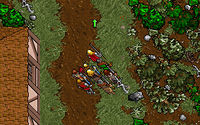
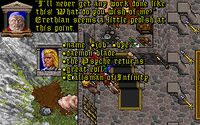
The huge, seamless world of Ultima VII, with its overflow of details and intricate design are the high point of realism in the series. Character control is greatly streamlined, with every action able to be performed with the mouse. The inventory and battle systems are improved and dialogue input is no longer handled by typing keywords, but rather by selecting them from a list.
The presentation and story have also become quite mature – the player is confronted with graphic crime scenes, drug use, racism and political corruption. Furthermore, the Guardian uses a clever and subtle plot to assert his power over the land, rather unlike the comparatively one-dimensional villains of the earliest games.
The Story[edit]
Spoiler warning: Plot and/or ending details follow.
A long time of peace has gone by in Britannia, with no great threats disturbing the lives of the people. Yet, something is amiss in the land. Magic seems to be dying, with mages becoming mad. The people are unhappy and feel spiritually empty and betrayed in life. A new sect called "The Fellowship" expands its membership in the lower classes and secures influence through their prominent members who ascend to leading positions in society.
The player again is the Avatar. One evening, a sinister red face appears on the Avatar's computer screen and declares its impending rule over Britannia. Alarmed, the Avatar consults the circle of stones and finds a moongate already waiting to send the hero to Trinsic. Upon arrival, it transpires that a brutal murder has occurred. Investigating, the Avatar learns of similar past murders and directly encounters further such killings while in Britannia. The Fellowship becomes incrementally more suspicious – in particular their leader, Batlin. Furthermore, a mysterious voice appears periodically to give the Avatar dubious guidance. Finally, after many perils the Avatar is reunited with the Time Lord, who reveals the true nature of recent events: The Fellowship is the puppet of the red-faced being, the Guardian. The Guardian has put in motion a plot to enter Britannia through a Black Gate and uses three blackrock Generators to spread his influence preceding his arrival. The Avatar destroys the Generators, then hurries to the Isle of the Avatar to intercept the completion of the Black Gate. In a brutal battle with Batlin and the elusive murderers, the latter are brought to justice while the former escapes by teleportation. Just before the Guardian can come through, the Avatar destroys the Gate.
Britannia is saved at the cost of the Avatar being stranded in the realm with an ominous threat of further turmoil and destruction left by the Guardian. Thus, the Age of Armageddon begins, continuing in Ultima Underworld II and Ultima VII Part Two.
Spoilers end here.
Development[edit]
Ultima VII continued where Ultima VI left off in technical development. Refining all the virtues of its predecessor, it pushed the envelope of contemporary PCs. The graphics employ the whole spectrum of 256-color VGA, the soundtrack is deep and atmospheric and digital recorded sound is used for the first time for the booming voice of the Guardian.
For the creation credits, see: Credits (Ultima VII)
Prototype[edit]
Interestingly, the back of the box shows screenshots which clearly are from an earlier build of the game, which never left Origin. As noted and shown in the article about the translations of the game, those boxes show different screenshots of the same early build. A report with much higher quality shots of the prototype was found, as seen in the gallery below.
The differences are numerous. There are some interesting differences in the floor tiles, with lots of gray tile floors and a very different wood floor being present. The grass also looks very flat and more like the grass found on the graveyard in the final game. An ankh shrine is glimpsed in Trinsic and two-handed swords are mirrored horizontally. Iolo's character portrait frame is that of the Avatar, not yet a custom one for the Yew area. The positioning of the dialogue and of the portraits is also very different. The closing buttons for the gumps are very different as well.
Differences between platforms[edit]
There are only two official versions of the game: the original PC release and a port for the SNES console.
The SNES-port is considerably shorter, streamlined and censored. The interactivity is greatly diminished, the world map is smaller and the quests are very simple in comparison to the original game, with no party to accompanying the Avatar. For more information, see SNES-port of Ultima VII.
Translations[edit]
Ultima VII was translated to several languages, including German, French and Spanish. For other languages, like Polish and Korean, only the documentation was translated. For more details, see Translations of Ultima VII.
Release[edit]
Ultima VII was a hit in 1992, but its sales were not enough to prevent the necessity of a takeover by Electronic Arts later in the year (just after Ultima Underworld II was released).
Ultima VII with Forge of Virtue was released as part of a bundle with nine other games in 1994 by Electronic Arts, which is called "Top Ten Pak", with all games being crammed onto a single CD-ROM and no paper documentation apart from a booklet (everything on CD).
The game was later included in several Ultima-compilations by Origin:
- The Complete Ultima VII (1993 and 1994)
- Ultima Collection (1998)
Distribution of the game in Europe was done by Mindscape.
In Japan, the game got included in the compilation Ultima Complete.
Included with the game[edit]
The release of Ultima VII included these things with the game:
- The Book The Book of Fellowship.
- A cloth map of Britannia in Ultima VII.
- A Fellowship Medallion (same as in the game).
- The Player Reference Card
- The Install Guide
Expansions[edit]
Forge of Virtue[edit]
- Main article: Ultima VII: Forge of Virtue
The Forge of Virtue is an add-on disk, published by Origin in 1992. With it installed, a totally new quest becomes available, which can be played at any time in the game. Today, it is included in the CD-ROM edition of Ultima VII, and one with the main program.
The Isle of Fire rises from the sea at the beginning of the game and Lord British fears the worst: the return of Exodus the Destroyer. He sends the Avatar to determine the dangers. The Avatar has to master the tests of the three Principles, in doing so necessitating the forging of the Black Sword. At its conclusion, the interference of the mage Erethian is thwarted and the Dark Core of Exodus is banished to the Void to prevent the beast's return. With this done, Lord British declares the Avatar to be a real hero, and all stats are maximized.
Included with it is the A Guide to the Isle of Fire pamphlet.
Upgrades[edit]
While the game is good enough for most people as it is, the game is usually almost impossible to run on modern computers and operating systems. The game uses Voodoo Memory Manager which is incompatible with any other memory manager using protected mode of the processor, such as Windows 95 and other 32-bit operating systems.
Exult[edit]
Exult is an open-source project that makes Ultima VII playable under Windows (and other operating systems) without problems, and with many improvements.
It is currently one of the best ways to run the game, if one does not mind slight deviation from the original gameplay; most of the improvements are quite benign, however, and whatever deficiencies are left are usually very minor. Exult is also a breeding ground for most of the modern fan-made Ultima VII mods, and the in-development versions of Exult make use of mods even easier.
See The Exult Project for more details.
Ultima VII in Windows[edit]
Dragon Baroque has developed a utility to run the original Ultima VII natively under Windows 95/98/ME/2000/NT/XP. See Gaseous Dragon's website for more information.
DOSBox[edit]
DOSBox is possibly the best way to run the game in its original form on modern computers. It is a virtual machine that can be used to run MS-DOS software in Windows, Linux, and Mac OS X (even on PowerPC). DOSBox is fully compatible with Ultima VII, without need for many changes.
Ultima VII auf Deutsch[edit]
Even though the game did get translated to German, the quality at times was uneven, and the translation was only available on floppy disks. Also Forge of Virtue was never translated. Ultima VII auf Deutsch is a fan-made patch by Sir John that addresses all of these problems and for the first time translates the entire CD-version of Ultima VII to German.
Ultima VII Nitpickers Delight Patch[edit]
The Ultima VII Nitpickers Delight Patch created by Sir John edits conversations and books in the game in order to fix factual and continuity errors in them. Additionally, several well-known bugs in the game are patched out as well. The patch is complete and available.
Ultima VII in Italiano[edit]
The project Ultima VII in Italiano is a fan translation of the game plus its expansion into Italian, since the original game never got translated into that language. That patch is presented as an Exult mod and is complete.
More Game Related Information[edit]
- For bugs in this game, see Ultima VII bugs.
- For cheating in this game, see Cheating in Ultima VII.
- For easter eggs and real-life references in this game, see Ultima VII real-life references and Easter eggs.
- For party members, see Party members in Ultima VII.
- For book and scroll information, see Books from Ultima VII, and Scrolls from Ultima VII.
- For monster data, see Ultima VII monster data.
- For detailed engine information, see Quirks of the Ultima VII engine.
- For copy protection, see Ultima VII copy protection.
- For food values and food sources, see Food in Ultima VII.
- For a walkthrough, see Ultima VII walkthrough.
- For where to find the various keys, see Key locations in Ultima VII.
- A useful tool for looking into the game data is the U7 Wizard.
Trivia[edit]
- Ultima VII is the last in the series to be produced by Origin before the company's takeover by publishing giant, Electronic Arts. At the time, the corporation was viewed unfavorably by Richard Garriott and is lampooned throughout the game: the three blackrock generators recall the corporation's then-prismatic logo, while the initials of elusive antagonists Elizabeth and Abraham form its commonly used acronym, "EA".
- Although predated by the full-speech FM Towns-port of Ultima VI, Ultima VII is the first entry developed from the outset to feature recorded dialogue, with Bill Johnson's performance as the Guardian.
- The intro offers an interesting piece of mind screw, since at first it appears like the Avatar is playing the actual game, though looking closer it turns out to be Fake Ultima VII.
- Additionally, the game shows a transition period inside Origin on how to create cutscenes. While the into apart from the Guardian himself is still traditionally drawn and animated, the outro already is in the render-graphics style which would be continued in Ultima VII Part Two and Ultima VIII.
- The Guardian's interjections throughout the game were originally planned to be juxtaposed with a "voice from below," in the form of thunderous rumblings, earthquakes, and volcanic eruptions. This second "voice" was intended to be first perceived ominously by the player, before being revealed as nature's reaction to the abuses inflicted upon the land.[1]
- Aspects of the Fellowship – notably the nature of its hierarchy – are an allusion to the new religious movement of Scientology.[2][3]
- Denis Loubet's stark, black box art for Ultima VII is the first of what was conceived as a trilogy of simple, thematically consistent covers. While the flame-emblazoned cover illustration of Ultima VIII continued this trend, the blue clouded sky first intended for Ultima IX's packaging did not come to fruition. In July 2016, Loubet completed an alternate Ultima VII cover (seen below right) as part of his ongoing Patreon campaign.[4]
- While a mouse is not listed as a requirement to play Ultima VII, the game is heavily designed around the peripheral. In reference to this fact, should no mouse be detected in the opening moments of the game, Iolo will break the fourth wall and urge, "Avatar, for the sake of our mutual sanity, I strongly suggest that thou shouldst purchase a mouse."
- An completion certificate could originally be obtained after winning the game.
Gallery[edit]
External Links[edit]
- The Exult Project
- Ultima VII: The Black Gate and Serpent Isle on Notable Ultima
- Ultima VII nitpicks
- Ultima 7 on Ultima Aiera
- Ultima VII: The Black Gate on Wikipedia
References[edit]
- ↑ DeMaria, Rusel et al. "A Conversation with Richard Garriott". Ultima: The Avatar Adventures. Prima Publishing: 1992. Page 384.
- ↑ DeMaria, Rusel et al. "A Conversation with Richard Garriott". Ultima: The Avatar Adventures. Prima Publishing: 1992. Page 381.
- ↑ Lankinen, Urpo. “The Fellowship and the Church of Scientology Compared”. 2005-09-27. Retrieved 2011-09-03.
- ↑ Loubet, Denis. “Finally! The Cover to Ultima VII That Never Was.”. Patreon. 2016-07-13. Retrieved 2016-07-20.
